‘Polycrisis’ is the buzz word among leftists right now. The word expresses the coming together and interlocking of various crises: economic (inflation and slump); environmental (climate and pandemic); and geopolitical (war and international divisions). Indeed, I raised a similar idea early last year.
So it is no surprise that the latest Human Development Report from the UN is so shocking. According to the HDR, the world is more pessimistic than at any point in modern history stretching back to before WW1.
The HDR analysed language trends in books over the past 125 years. It reveals a sharp increase in expressions reflecting “cognitive distortions associated with depression and other forms of mental distress”. Over the past two decades the language reflecting overly negative perceptions of the world and its future has surged. Indeed, today’s distress levels are unprecedented, exceeding those during the Great Depression and both world wars.
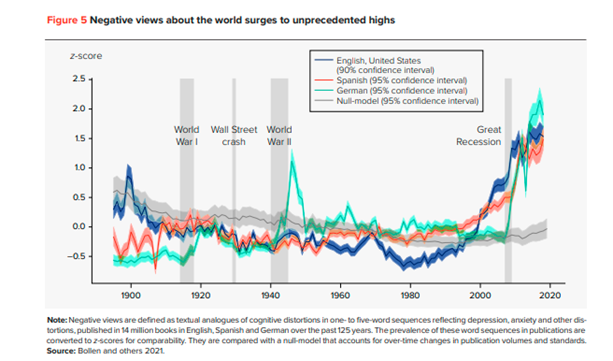
What’s also revealing is that negative views about the world began to soar around the turn of the century – even before the Great Recession. This surge coincides with my own economic insight that the major economies of the world entered what I call a new Long Depression, the third in the history of modern capitalism after the depression of 1873-95 and the Great Depression of the 1930s.
The intensity of negative views about the prospects for humanity has never been higher – way higher than in either of the two world wars of the 20th century. We are in a combination of: an economic depression; where real incomes stagnate or even fall; poverty increases along with widening inequality; and where investment to boost the productive forces and solve the environmental disaster now engulfing the world is lacking. And where instead of global cooperation by governments to solve this ‘polycrisis’, we have increasing conflict between nations, both economic and military.
Achim Steiner, Administrator United Nations Development Programme, presented the HDR 2022. This is how he introduced it. “We are living in uncertain times. The Covid-19 pandemic, now in its third year, continues to spin off new variants. The war in Ukraine reverberates throughout the world, causing immense human suffering, including a cost-of-living crisis. Climate and ecological disasters threaten the world daily.”
He went on: “Layers of uncertainty are stacking up and interacting to unsettle our lives in unprecedented ways. People have faced diseases, wars and environmental disruptions before. But the confluence of destabilizing planetary pressures with growing inequalities, sweeping societal transformations to ease those pressures and widespread polarization present new, complex, interacting sources of uncertainty for the world and everyone in it.”
“People around the world are now telling us that they feel ever more insecure.” Six out of seven people worldwide reported feeling insecure about many aspects of their lives, even before the Covid-19 pandemic. And the political consequences: “Is it any wonder, then, that many nations are creaking under the strain of polarization, political extremism and demagoguery—all supercharged by social media, artificial intelligence and other powerful technologies?”
Steiner pointed out that “in a stunning first, the global Human Development Index value has declined for two years in a row in the wake of the Covid-19 pandemic.”

The decline in the global HDI puts it back to the time just after the adoption of the 2030 Agenda for Sustainable Development and the Paris Agreement! So no progress there. Every year a few different countries experience dips in their respective HDI values. But a whopping 90 percent of countries saw their HDI value drop in either 2020 or 2021, far exceeding the number that experienced reversals in the wake of the global financial crisis. Last year saw some recovery at the global level, but it was partial and uneven: most very high HDI countries notched improvements, while most of the rest experienced ongoing declines.
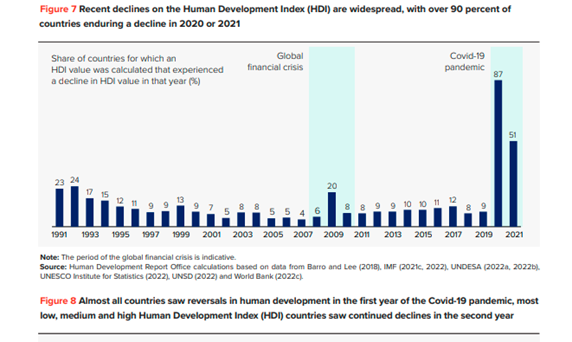
At least 15m ‘unnecessary lives’ were lost from the COVID pandemic, mostly in low- and middle-income countries. But even the US saw its life expectancy fallen to the lowest level in 26 years. Indeed, US life expectancy is now below that of China!
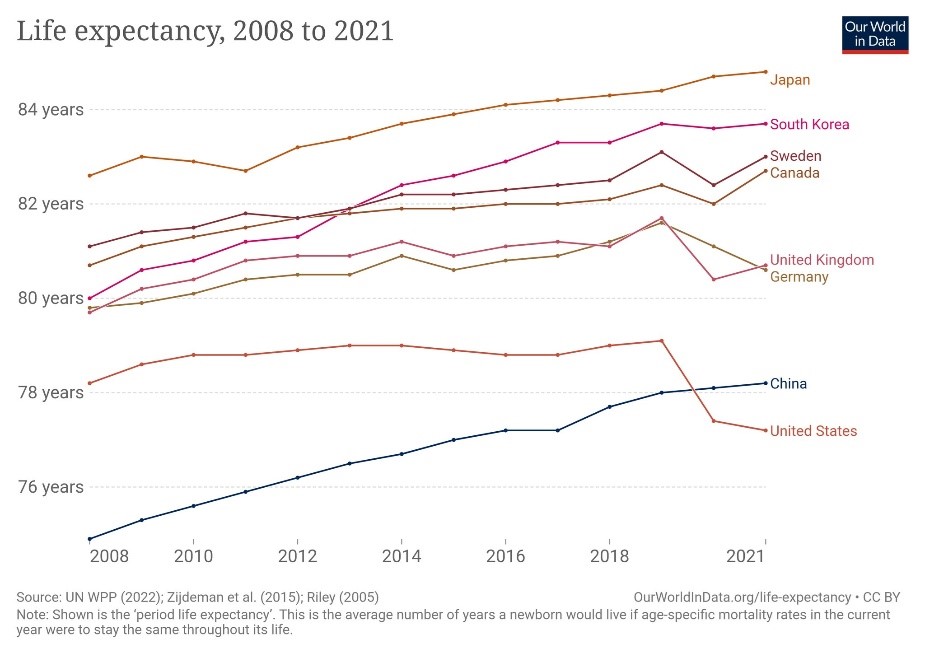
New vaccines were developed to fight COVID in double-quick time, including some based on revolutionary technology and they saved an estimated 20 million lives in one year. But the poorest in the world received the least medical support because highly unequal vaccine access “The pandemic has been a painful reminder of how breakdowns in trust and in cooperation, among and within nations, foolishly constrain what we can achieve together.”
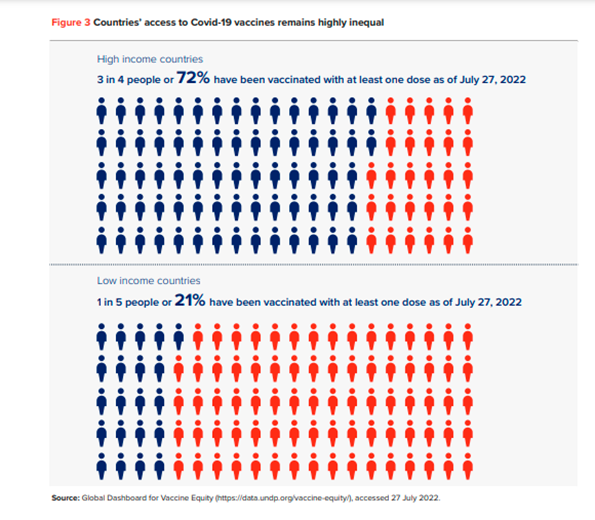
COVID has not gone away, but governments and people have decided to live (and die) with it. The aftermath remains and even worsens. Billions of people now face the greatest cost-of-living crisis in a generation. They are already grappling with food insecurity, owing largely to inequalities in wealth and power that determine entitlements to food. Global supply chain blockages remain, contributing to rising inflation in all countries at rates not seen in decades.
As for the climate, the HDR reminds us that in recent years have seen more record temperatures, fires and storms around the world. The latest International Panel on Climate Change Report is a “code red for humanity.” In essence, as science has advanced, the climate models are, with better precision than before, predicting more disasters ahead. As “the climate crisis marches on, alongside other planetary-level changes wrought by the Anthropocene.” Biodiversity collapse is one of them. More than 1 million plant and animal species face extinction. “We have even less of an idea of how to live in a world without, say, an abundance of insects. That has not been tried for about 500 million years, when the world’s first land plants appeared. This is not a coincidence. Without an abundance of insect pollinators, we face the mindboggling challenge of growing food and other agricultural products at scale.”
The polycrisis is affecting humanity’s mental wellbeing through traumatizing events, physical illness, general climate anxiety and food insecurity. “The effects these have on children in particular are profound, altering brain and body development, especially in families on lower social rungs, potentially diminishing what children can achieve in life.” Inequalities in human development are perpetuated across generations; “it is not difficult to see how the confluence of mental distress, inequality and insecurity foment a similarly injurious intergenerational cycle that drags on human development.”
With economic depression and ecological disaster comes uncertainty, insecurity and political polarization. Large numbers of people feel frustrated by and alienated from their political systems. Armed conflicts are also up. For the first time ever, more than 100 million people are forcibly displaced, most of them within their own countries.
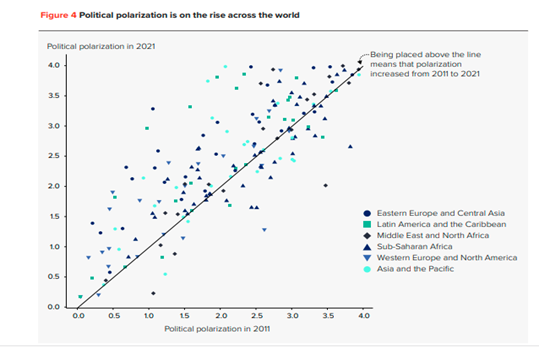
What is to be done? The UN offers its model for a more hopeful future: investment, insurance and innovation—the three Is.
But innovation and new technology, the UN admits, is a double-edged sword. “Artificial intelligence will both create and destroy tasks, causing tremendous disruption. Synthetic biology opens new frontiers in health and medicine while raising fundamental questions about what it means to be human.” Indeed, will these new technologies increase inequality, reduce job possibilities or expand them? I have discussed this issue in previous posts.
Then there is investment. The HDR talks about public investment, particularly for the environment. But says nothing about the vested interests that stand in the way of such investment. Finally, there is insurance: more protection of human rights, access to basic services and minimum incomes, and more democratic accountability. None of this basic insurance exists for the majority of the world’s near 8bn people.
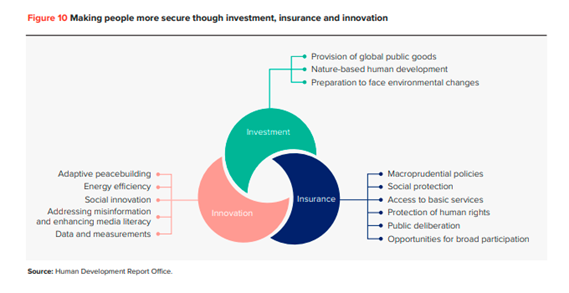
The UN report is devastating in its examination of the human condition in the 21st century. But it offers no convincing explanation of why there is a ‘polycrisis’. Achim Steiner tells us that “the hero and the villain in today’s uncertainty story are one in the same: human choice.” Really, so if we chose to do things differently, we could. So why doesn’t humanity choose a different path? Well, it is because “not all choices are the same. Some—arguably the ones most relevant to the fate of our species—are propelled by institutional and cultural inertia, generations in the making.” Institutional and cultural inertia? Surely, the reason lies with the reality that only a tiny percentage of humanity can choose; the rest of us do not have the power to choose (at least not individually). It is the class division with capitalism, between those who own and control and those who must work for them and obey, that is the fundamental cause of this polycrisis, “generations in the making.”
Intersectional crisis!
Hello Michael,
Thanks for another interesting post.
I case its of interest, I wrote a piece for The Critic in December about crisis fatigue and the impact on our imaginations. Just thought I’d send over as it relates a little bit to the themes in your piece https://thecritic.co.uk/inescapable-crisis/
Best wishes, Dave
Prof. David Beer Professor of Sociology Department of Sociology Law and Sociology Building University of York Heslington York UK YO10 5GD
Website: https://davidbeer.net
I am too depressed to comment. Fat chance. As you know I was the first to anticipate the four horsemen of the Apocapitalise when I analyzed the sharp contraction in the global economy in 2019, which led me to in turn predict that the 2020s would be the decade of make or break for humanity. As they say, the darkest hour is the hour before the revolution.
Great article by the way.
This describes a western centric view, which is no doubt accurate- the age of the doomers. Degrowth, calamity, and austerity. But how does this apply to the rest of the world? Would Chinese polls show disillusionment with institutions for instance? Or even in Russia? The fact that BRI and the emergence of the Eurasian and Indo-Pacific spheres bodes well for Asia, the Middle East, and Africa tell a much different story: production is healthy and we are headed for an explosion of the forces of production in that part of the world.
Sorry, the USA and Europe are not going to be part of this- our elites have made up their minds. But the “doomer” mentality isn’t universal. The final death of the Liberal International Order will be a wimper as the global south vaults ahead.
The only thing Marxists need to do is be ready for when the dollar system crashes and burns.
Well, so far as I can tell there are no “Eurasian and Indo-Pacific spheres” in the sense implied. The Shanghai Communication Organization is not a close alliance. BRICS is a string of letter, not a bloc. Worst of all the notion that the Belt and Road Initiative will give world capitalism a new lease on life is the pro-capitalist delusion. It’s the New Silk Road…to Nowhere in my opinion. The constant avowals that China will continue Reform and Opening Up more and more are a commitment to failure if they are carried out, also in my opinion. There’s a vague hint that doing in the US will cure imperialism but, nope.
The Human Development Report would make more sense if “institutional and cultural” were admitted to include private property in the means of production and the class nature of the bourgeois state. As is, it’s like those Blue Books Marx and Engels used?
Nice, dead pan and Swiftian post….
Capital needs these crises and profitable technical (pharmacological and military/industrial) solutions to remain afloat. The more pessimitic and frightened the populace the better.
You have to be a marxist to be optimistic….but apparaently not a typical “Western maxist”.
Polycrises are not unique. They are rare, though, as they are signs great civilizations are coming to an end. For example, it was a polycrisis that ended the Bronze Age Civilization, and one that also ended the Roman Empire.
So far, all of them involved at least one major natural global catastrophe (an epic drought in the case of the Bronze Age; a series of plagues/pandemics in the case of the Roman Empire), so the fact that global warming and COVID-19 are factors is not surprising: human beings have been, are, and will always be, exterminated by natural cataclysms – this is just part of being a life form. This will continue to happen until the day we’re extinct – probably in the hands of one or more natural cataclysms.
However, in this specific case, I think this will only be the end of Western Civilization (golden age capitalism), not of humanity as whole. I think I’ve already mentioned here, but I consider a USSR sudden, purely political, collapse impossible in the USA. Capitalism is a decentralized system, impossible to be collapsed by a single political episode that is not a communist revolution. It will collapse in a polycrisis, which will probably extend for decades and maybe more than a century. Just see the case of the British Empire, which did not fall in one single political event, but in a series of crises that culminated in big sell off of the Empire of WWII to the Americans (soon to be American Empire).
The Americans will agonize before they collapse.
Another evidence that this polycrisis is essentially a case of the fall of a civilization and not of the whole humanity is that optimism about the future is at an all time high in China (search on the internet the diverse polls done last year). China continues to thrive economically and socially because, as the socialist superpower, it is still in the ascendant phase. If it was a true global polycrisis, pessimism should be universal, which it isn’t for this case.
It is normal for the people of a world empire to think the world is ending when they witness the fall of their empire. The Roman people also thought it was the end of the world when Rome in the West fell; this kind of apocalyptic thinking is common for people accustomed to confuse the entire world with their own empire. That the Americans and Europeans are thinking, speaking and writing about the end of the world is not evidence the world is really ending.
The only x factor that exists today that can demolish this scenario, that never existed before, is the nuclear arsenal of the USA, which can extinguish humanity effectively instantly. MAD is the only realist scenario for the immediate extinction of the homo sapiens in this present historical era. But that’s a factor fully in control of the American Empire: they just must not press the proverbial button and it will never happen.
“MAD is the only realist scenario for the immediate extinction of the homo sapiens in this present historical era. But that’s a factor fully in control of the American Empire: they just must not press the proverbial button and it will never happen.”
Only someone who is MAD “thinks” that “the only realist scenario for the immediate extinction of the homo sapiens” is by the murderous empire of psychopaths not to push the button as if, without that, immediate extinction-preventive sanity rules with homo “sapiens” when the exact opposite applies — see “The 2 Married Pink Elephants In The Historical Room” … https://www.rolf-hefti.com/covid-19-coronavirus.html
“Never hide the truth to spare the feelings of the ignorant.” — Mikhail Bulgakov
There is only ONE crisis, in development for fourteen years, wich will only get worse, that cannot be avoided and implies the demise of industrial society : “Global conventional crude oil production peaked in 2008 at 69.5 mb/d and has since fallen by around 2.5 mb/d.” Page 45 of the World Energy Outlook 2018 by the International Energy Agency.
And yet, total production in 2018 was 20% above 2008 levels as “tight oil”-shale production has brought US production to higher output.
“Conventional” does not include shale, tar sands, etc. sources.
Deep conclusion of your articule: the capitalist class society as the fundamental cause of the polycrisis. Exactly, there you arrive at the real and scientifically known ultimate cause today. A cause that eliminates supposed and false causes such as institutions and culture, but there are many more false causes sold by socioliberals and others: race, religion, sex, West-East . And a cause that even eliminates the geopolitical conflict and the environmental conflict as ultimate causes. ? Why does he do this? Because these conflicts ONLY harm the subordinate working classes. Is it necessary to provide data that elites and the capitalist class are increasing their benefits with these polycrises? It goes without saying and demonstrating that these polycrises are really generated by the elites, both from the West and the East, to increase their profit rates and that these extra profits are paid exclusively by the working class. Its benefits are the sole cause of our crises and nothing else is. Yesterday, today and tomorrow, and before Socialism.
The response that I’ve noticed which has grown by leaps and bounds is what I call ‘socialised paranoia’. The delusions of grandeur of everyday conspiracy ‘theorists’ as well as a generalised sense of persecution are all over the place.
Another sign a given great civilization is dying which is very useful for historians is when the mode of production of said civilization survives apparently stronger than ever, but working the way it shouldn’t work.
E.g. during Commodus, the patronage system that kept the Roman Empire centralized collapsed, but the whole thing only tent down some one hundred years (after the Crisis of the Third Century, after which the Roman Empire became a protofeudal system thanks to the Diocletian Reforms).
After the Diocletian Reforms, the local Roman elites praised him, saying he saved and fully restored Rome to its former glory. Here we have a glaring example of how perception is not reality, but at least they could use the excuse of not having Wikipedia, statistics or something like that.
Capitalism should always work through economic discipline: all punishment should be monetary in nature, e.g. a bad or rebel worker is fired from his or her job, not imprisoned or executed (political discipline). Every social relation in capitalism, when it is working as it should be, must be of monetary compensation and subtraction – that is the theoretical basis for freedom-on-free-commerce, that is, that violence is not needed in capitalism anymore because the “agents” of the “free market” behave under the hand of circulation of money.
Hence, for example, the capitalists were proud of themselves when they claimed, during the Cold War, that they didn’t have to arrest or execute anybody for expressing their opinions, because they have the discipline of money, the discipline of the free market. Political discipline was the disease of the USSR.
But now, in the 21st Century, we can clearly see the capitalism cannot impose the discipline of the money the way it could during the second half of the 20th Century. The USA is having to resort more and more to political/juridical discipline in order to keep capitalism going: prison labor, bizarre union busting legislation, baseless economic sanctions (sanctions based on morality and not on economy, but which have the appearance of the economic), financialization (extraction of surplus from the rest of the world through fictitious capital such as IP, “national security” etc.) and by erecting artificial trade barriers (commercial sabotage – see the Nordstream 2 destruction – and regime change to more anti-China and anti-Russia governments in the borderlands of Eurasia).
The USA is weaker than ever. The only moment it was weaker was during the initial years of its Revolutionary Phase (1776-1861), when it was still an infant project that could have been destroyed by a still ascendant British Empire in the cradle. It is having to resort more and more to political discipline in order to save capitalism. The problem is that’s not how capitalism should work, and historians should observe this phenomenon closely.
“Capitalism should always work through economic discipline…” This is only the claim made, a false consciousness. State power has always been implicated in the development of capitalism, from the expropriation of the commons or the Church lands or the role of the state in coining money. State power is essential to creating national currency, national markets, national territory. And all of this means violence, the threat of violence and the fear of violence. That’s why the history of capitalism is inseparable form the history of war, conquest.
And the notion that domestic violence, that is “political/juridical discipline,” wasn’t used in the latter half of the twentieth century forgets that the Cold War wasn’t just foreign affairs. It was marked by the massive purge of the labor movement, the mass repression of the Communist Party The attempts to maintain the mass repression of African Americans, women and gays. It wasn’t just mass propaganda for “free enterprise” and the family and religion all involved discipline, as in KKK and White Citizens’ Councils. Anti-union legislation began not after capitalism (somehow reduced to the US alone, instead of being a worldwide system?) in 1948, not after the capitalists started going broke. It was the capitalists going broke in the Depression that led indirectly to pro-union legislation (every item of which was bitterly contested) not the other way round.
The notion that sanctions are moral crusades instead of economic warfare aimed at enemy populations implies that popular outrage drives them. Popular outrage is manufactured. The costs of economic warfare are like the costs of war, the nation as a whole suffers—but it’s the interests of the ruling class, a small minority that drive the decisions. The hope for great gains while the costs are borne by the masses is ultimately irrational. But the capitalist system is crazy, and getting crazier. (Which is why MAD is no guarantee, even if nukes are possibly more likely to be first used by Israel and India.)
The American Revolution began in 1775. The replacement of the Articles of Confederation by the US Constitution marked a retreat, somewhat homologous to the Directory replacing the Jacobins, except that the US parallel lasted, instead of devolving into a superficial restoration. The next revolutionary phase in US history *began* in 1861, ending more or less in 1876, 1877 with the so-called Compromise withdrawing troops from the South and beginning the so-called Redemption process. Along with the commitment to capitalism, exemplified most of all by its hard-money fetish and the suppression of labor in the great struggles of 1877, plenty of domestic violence against dissidents were the norm for decades.
Well, who said economics was a dismal science ? Thank you for always looking on the bright side.
Thank you very much for your words, I completely agree maria gianotti
Your Post has now been translated into Korean, as below.
https://sumbolon.blogspot.com/2023/01/polycrisis-21-by-michael-roberts.html
Thank you much for your comments.